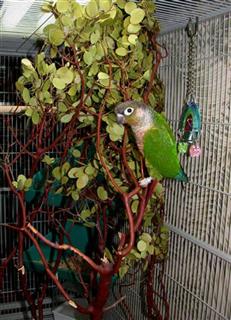Conure- Green cheeked
Yellow Sided Conure Scientific Name: Pyrrhura molinae molinae
Tue, 15th July, 2025 - 9:33 pm GMT
Sponsor Ads:

Alternative Name
Yellow Sided Conure Scientific Name: Pyrrhura molinae molinaeBasic Info
At maturity, Green-cheeked Conures are generally around ten inches in length. Their feathers are predominantly green, although the secondary and primary flight feathers are blue. A frontal band is present and it is narrow and mahogany colored. The nape, throat, and upper breast are all greenish brown, but the nape may include some pretty blue feathers. Each feather on the Green-cheeked Conure's nape, throat, and upper breast is edged with a dull yellow-gray, giving the feathers definition and having the effect of scales typical to Conures. The ear coverts, forehead and back of the head are all brown, and the abdomen is mahogany in color. The tail underside is also mahogany, and the upperside has feathering of the same color over a green base. This is largely hidden by the Green-cheeked Conure's tail-coverts. The undertail coverts have a blue hue to them. Green-cheeked Conures have the white skin around their periopthalmic ring that is typical to Conures, and their irises are brown. Their bills are gray, and they have a generally lovely appearance. There are at least two popular color mutations for the Green Checked Conure, these are the Fallow Green Cheeked Conure, and the Yellow Sided Conure.
Health
Some Green-cheeked Conures do become a bit grumpy or nippy as they get older. In Australia, it is illegal to own these lovely birds without a license and in some states it is illegal to keep them, so check with your local government. Make sure that any toys you give your Green-cheeked Conure will not catch on his band! The average lifespan of the Green Cheeked Conure is 10 years, though their potential lifespan is 30 years. They often fail to live long lives because of improper diet and care. Breeding Green-cheeked Conures should be surgically or DNA sexed. DNA sexing is the simpler procedure and is a bit easier on the Conure physically and mentally! Immature Green-cheeked Conures have much duller plumage than adults, and their irises are darker. They have much less mahogany feathering over their abdomens than do adults.Habitat
N/ABehavior
The Green-cheeked Conure is a favorite of bird owners everywhere because of their sweet personalities and exquisite coloration! The Bolivian Green-cheeked Conure is an intelligent, playful bird who can be taught to say simple words and phrases! Although they can screech very loudly, they usually are one of the more quiet varieties of Conure. Green-cheeked Conures should be kept in as large a cage as possible- the minimum is 18 inches by 18 inches by 22 inches. They need lots of sunlight, fresh air, and time out of their cages for playing and cuddling with you! Green-cheeked Conures also love bathing, and will enjoy showering with you provided the water is not too hot! Apart from a bathing pan, Green-cheeked Conures need fresh water in their cages at all times. It is also very important that your Green-cheeked Conure has a nesting box in his cage, so that if he feels stressed he can lay low for a while! Conures also enjoy sleeping in the dark, quiet security of their nesting boxes. They love to chew and need lots of sturdy toys. Green-cheeked Conures are very affectionate birds who will form very strong, loving bonds with their keepers. They are also quite good with children.Origin
BoliviaHistory
Green-cheeked Conures are native to eastern Bolivia's highlands. Because they are wild birds, many places require a license to keep them. Remember that on the whole, captive-bred birds will make better pets than wild-caught birds. Green-cheeked Conures were first recorded by Massena and Souncé in 1854. They are known as Gruenwangen-Rotschwanzsittich in German.Common Foods
You should feed them a good pellet diet and/or fortified seed-mix supplemented with a variety of fresh fruits, vegetables and legumes.Sponsor Ads:
We reject kings, presidents and voting. We believe in rough consensus and running code. -- Dave Clark
Conure- Green cheeked
Coded by: BGID® | ALL RIGHTS RESERVED Copyright © 2000-2025
Disclaimer | Privacy | Report Errors / Contact | Credits








 President of the United States of America - Real Estate mogul, Pageant owner and now one of the most controversial men in political history.
President of the United States of America - Real Estate mogul, Pageant owner and now one of the most controversial men in political history.  Global warming has been in and out as the "latest" hot topic for many years. It is, according to modern scientists, the result of man-made industrial pollutants, clearing forested areas, agriculture, etc. But now they are thinking it started way before the Industrial Revolution...
Global warming has been in and out as the "latest" hot topic for many years. It is, according to modern scientists, the result of man-made industrial pollutants, clearing forested areas, agriculture, etc. But now they are thinking it started way before the Industrial Revolution...  Politician, US Vice President and President of the USA - Joseph Robinette Biden Jr.
Politician, US Vice President and President of the USA - Joseph Robinette Biden Jr.  versus
versus  Russia: 'The Evil Empire'? Are they all that bad or is it just the USA trying to portray Russia as bad because they are a world power with land bigger and a society very different from the USA ideal?
Russia: 'The Evil Empire'? Are they all that bad or is it just the USA trying to portray Russia as bad because they are a world power with land bigger and a society very different from the USA ideal? 
 Corona virus
Corona virus 
 Users with wide screen monitors can benefit from more content on every page.
Users with wide screen monitors can benefit from more content on every page.